Related Research Articles

Cognitive neuroscience is the scientific field that is concerned with the study of the biological processes and aspects that underlie cognition, with a specific focus on the neural connections in the brain which are involved in mental processes. It addresses the questions of how cognitive activities are affected or controlled by neural circuits in the brain. Cognitive neuroscience is a branch of both neuroscience and psychology, overlapping with disciplines such as behavioral neuroscience, cognitive psychology, physiological psychology and affective neuroscience. Cognitive neuroscience relies upon theories in cognitive science coupled with evidence from neurobiology, and computational modeling.

Brodmann area 9, or BA9, refers to a cytoarchitecturally defined portion of the frontal cortex in the brain of humans and other primates. It contributes to the dorsolateral and medial prefrontal cortex.
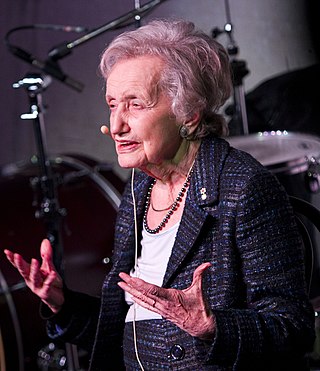
Brenda Milner is a British-Canadian neuropsychologist who has contributed extensively to the research literature on various topics in the field of clinical neuropsychology. Milner is a professor in the Department of Neurology and Neurosurgery at McGill University and a professor of Psychology at the Montreal Neurological Institute. As of 2020, she holds more than 25 honorary degrees and she continued to work in her nineties. Her current work covers many aspects of neuropsychology including her lifelong interest in the involvement of the temporal lobes in episodic memory. She is sometimes referred to as the founder of neuropsychology and has been essential in its development. She received the Balzan Prize for Cognitive Neuroscience in 2009, and the Kavli Prize in Neuroscience, together with John O'Keefe, and Marcus E. Raichle, in 2014. She turned 100 in July 2018 and at the time was still overseeing the work of researchers.
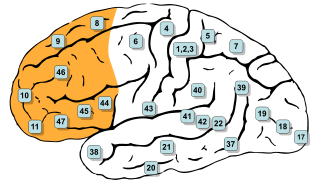
In mammalian brain anatomy, the prefrontal cortex (PFC) covers the front part of the frontal lobe of the cerebral cortex. The PFC contains the Brodmann areas BA8, BA9, BA10, BA11, BA12, BA13, BA14, BA24, BA25, BA32, BA44, BA45, BA46, and BA47.

In cognitive science and neuropsychology, executive functions are a set of cognitive processes that are necessary for the cognitive control of behavior: selecting and successfully monitoring behaviors that facilitate the attainment of chosen goals. Executive functions include basic cognitive processes such as attentional control, cognitive inhibition, inhibitory control, working memory, and cognitive flexibility. Higher-order executive functions require the simultaneous use of multiple basic executive functions and include planning and fluid intelligence.

Cambridge University primate experiments came to public attention in 2002 after the publication that year of material from a ten-month undercover investigation in 1998 by the British Union for the Abolition of Vivisection (BUAV). The experiments were being conducted on marmosets, and included the removal of parts of their brains intended to simulate the symptoms of stroke or Parkinson's disease. Some of the research was theoretical, aimed at advancing knowledge of the brain, while some of it was applied.

In neuroanatomy, the parieto-occipital sulcus is a deep sulcus in the cerebral cortex that marks the boundary between the cuneus and precuneus, and also between the parietal and occipital lobes. Only a small part can be seen on the lateral surface of the hemisphere, its chief part being on the medial surface.
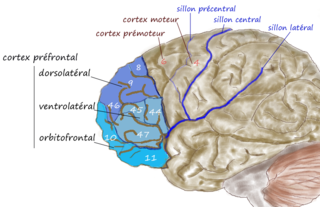
The dorsolateral prefrontal cortex is an area in the prefrontal cortex of the primate brain. It is one of the most recently derived parts of the human brain. It undergoes a prolonged period of maturation which lasts into adulthood. The DLPFC is not an anatomical structure, but rather a functional one. It lies in the middle frontal gyrus of humans. In macaque monkeys, it is around the principal sulcus. Other sources consider that DLPFC is attributed anatomically to BA 9 and 46 and BA 8, 9 and 10.

Patricia Goldman-Rakic was an American professor of neuroscience, neurology, psychiatry and psychology at Yale University School of Medicine. She pioneered multidisciplinary research of the prefrontal cortex and working memory.
Trevor William RobbinsCBE FRS FMedSci is a professor of cognitive neuroscience and the former Head of the Department of Psychology at the University of Cambridge. Robbins interests are in the fields of cognitive neuroscience, behavioural neuroscience and psychopharmacology.
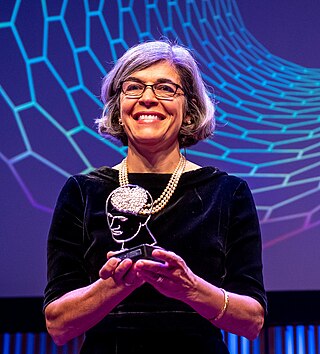
Anna Christina Nobre FBA, MAE, fNASc is a Brazilian and British cognitive neuroscientist working at the University of Oxford in England.

Earl Keith Miller is a cognitive neuroscientist whose research focuses on neural mechanisms of cognitive, or executive, control. Earl K. Miller is the Picower Professor of Neuroscience with the Picower Institute for Learning and Memory and the Department of Brain and Cognitive Sciences at Massachusetts Institute of Technology. He is the Chief Scientist and co-founder of SplitSage.
The Cambridge Neuropsychological Test Automated Battery (CANTAB), originally developed at the University of Cambridge in the 1980s but now provided in a commercial capacity by Cambridge Cognition, is a computer-based cognitive assessment system consisting of a battery of neuropsychological tests, administered to subjects using a touch screen computer. The CANTAB tests were co-invented by Professor Trevor Robbins and Professor Barbara Sahakian. The 25 tests in CANTAB examine various areas of cognitive function, including:

Robert Desimone is an American neuroscientist who currently serves as the director of the McGovern Institute for Brain Research and the Doris and Don Berkey Professor of Neuroscience at the Massachusetts Institute of Technology.

Joaquin M. Fuster is a Spanish neuroscientist whose research has made fundamental contributions to the understanding of the neural structures underlying cognition and behavior. His several books and hundreds of papers, particularly on memory and the prefrontal cortex, are widely cited.

Adrian Mark Owen is a British neuroscientist and best-selling author. He is best known for his 2006 discovery, published in the journal Science, showing that some patients thought to be in a persistent vegetative state are in fact fully aware and able to communicate with the outside world using functional magnetic resonance imaging (fMRI). In the 2019 New Year Honours List, Owen was made an Officer of the Most Excellent Order of the British Empire (OBE) for services to scientific research.
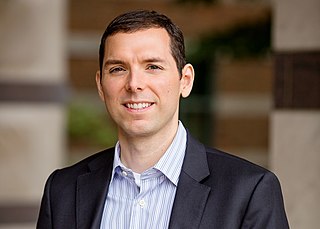
Aron Keith Barbey is an American cognitive neuroscientist, who investigates the neural architecture of human intelligence and brain plasticity. Barbey is the Emanuel Donchin Professorial Scholar of Psychology and a Professor of Psychology, Neuroscience, and Bioengineering at the University of Illinois. He is director of the Decision Neuroscience Laboratory at the Beckman Institute for Advanced Science and Technology, and founding director of the Center for Brain Plasticity at the Beckman Institute, where he leads the Intelligence, Learning, and Plasticity (ILP) Initiative.

Wendy Suzuki is a Professor of Neuroscience and Psychology at the New York University Center for Neural Science and popular science communicator. She is the author of Healthy Brain, Happy Life: A Personal Program to Activate Your Brain and Do Everything Better. Since September 1, 2022, she has served as Dean of the New York University College of Arts & Science.
Joni Wallis is a cognitive neurophysiologist and Professor in the Department of Psychology at the University of California, Berkeley.
Amy F.T. Arnsten is an American neuroscientist. She is the Albert E. Kent Professor of Neuroscience and Professor of Psychology as well as a member of the Kavli Institute of Neuroscience at Yale University.
References
- 1 2 3 4 "Angela Roberts". Neuron. 104 (1): 9–10. October 2019. doi: 10.1016/j.neuron.2019.09.033 . ISSN 0896-6273.
- 1 2 3 "Member Details". my.sfn.org. Retrieved 2023-07-05.
- ↑ "Speakers - Cell Symposia Cell Symposia: The Biology of Neuropsychiatric Disorders". www.cell-symposia.com. Retrieved 2023-07-05.
- ↑ "Angela Roberts | WorldCat.org". www.worldcat.org. Retrieved 2023-07-05.
- ↑ "Angela C. Roberts, Ph.D." Brain & Behavior Research Foundation. 2020-09-24. Retrieved 2023-07-05.
- ↑ "Professor Angela Roberts | The Academy of Medical Sciences". acmedsci.ac.uk. Retrieved 2023-07-05.
- ↑ "Goldman-Rakic Prize for Outstanding Achievement in Cognitive Neuroscience". Brain & Behavior Research Foundation. 2017-03-31. Retrieved 2023-07-05.